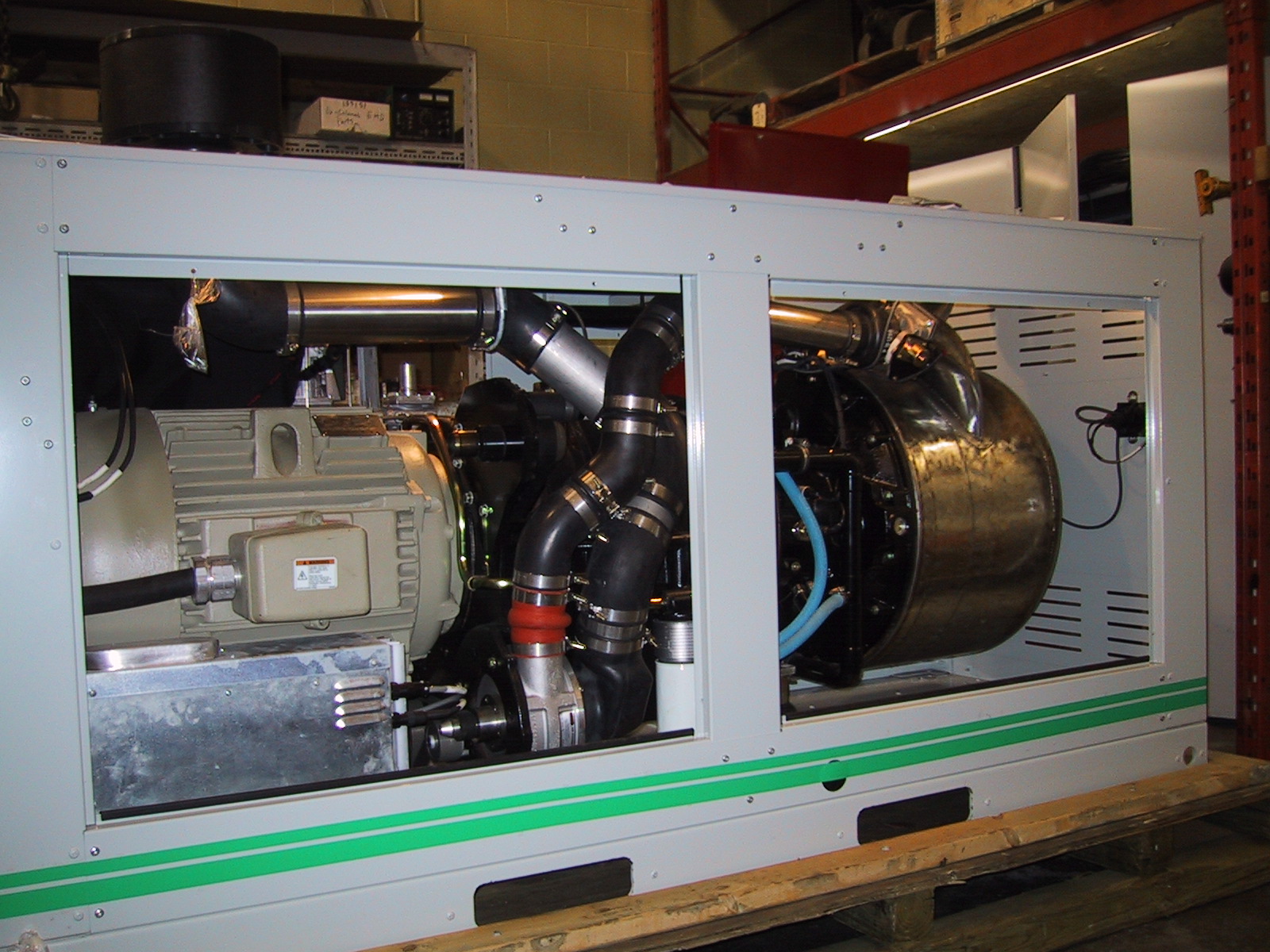Sidebar
What can I choose in the calculator?
Classical Decentralised Cogeneration
 Stirling engine/generator set by STM Power Inc.
Stirling engine/generator set by STM Power Inc.
Contents
- Impact
- Global market
- Definition
- Constraints
- Assumptions
- References
IMPACT – What are the impacts of Decentralised Cogeneration?
Energy system
![]() Reduce final energy demand.
Reduce final energy demand.
![]() Likely to increase total fossil fuel consumption.
Likely to increase total fossil fuel consumption.
![]() Unlikely to promote an increased share of renewable energy sources in the energy mix.
Unlikely to promote an increased share of renewable energy sources in the energy mix.
![]() Likely to reduce pressure on the grid by providing distributed generation capacity.
Likely to reduce pressure on the grid by providing distributed generation capacity.
![]() Likely to decrease energy independence.
Likely to decrease energy independence.
![]() Likely to increase energy security by reinforcing the grid with distributed generation.
Likely to increase energy security by reinforcing the grid with distributed generation.
Environment & Climate
![]() Likely to reduce global CO2 emissions.
Likely to reduce global CO2 emissions.
![]() Unlikely to increase deposited waste
Unlikely to increase deposited waste
Society & Economy
![]() Likely to increase the cost of the energy transition.
Likely to increase the cost of the energy transition.
![]() May worsen balance of payments by increasing fossil fuel imports.
May worsen balance of payments by increasing fossil fuel imports.
![]() May increase Confederation income from the tax on mineral oil under the current taxation system
May increase Confederation income from the tax on mineral oil under the current taxation system
![]() Can potentially provide consumers with power in emergencies and during grid failures.
Can potentially provide consumers with power in emergencies and during grid failures.
GLOBAL MARKET – What is the global market for Decentralised Cogeneration?
DEFINITION / CONSTRAINTS
DEFINITION - What is Decentralised Cogeneration?
In a combined heat and power (CHP) plant, the energy from a fuel is used to generate both electricity and heat. Thermodynamically, the heat is recovered from the waste heat of the electricity generation process, resulting in a higher overall energy efficiency than can be achieved if the processes are operated separately.
Decentralised cogeneration, or CHP, systems are targeted at the residential, commercial and small industrial markets.
In the commercial and industrial markets, the cogeneration systems could use either gas turbines or internal combustion engines. In the residential market the primary technology is natural gas or fuel oil fired internal combustion engines, as gas turbines are not a good match for typical residential electricity demand levels.
Wood or biomass fired systems are also available but mostly at larger capacity levels that are better suited for centralised deployment. Other technologies such as Stirling engines are also available though less common.
CONSTRAINTS - What are the key barriers facing Decentralised Cogeneration deployment?
• Decentralised cogeneration systems need to be connected to the electricity grid to be more reliable and this can be challenging from a technical and regulatory viewpoint.
• The capital cost of cogeneration systems is significantly higher than the one of more conventional technologies.
• A significant fraction of both the electricity and heat output of a distributed CHP system must be used to make the system cost effective. It can often be challenging to simultaneously match both loads in small distributed applications.
ASSUMPTIONS – What are the assumptions considered in the calculator?
The model contain five types of decentralized cogeneration technologies: micro gas turbine (100kWe), natural gas internal combustion engine (50kWe and 160kWe), diesel internal combustion engine (200kWe) and stirling engine (wood combustion, 3kWe).
Next tables contain the assumptions that have been introduced in the Centralized cogeneration model of the calculator.
| Efficiency [%] | ||||
|---|---|---|---|---|
| 2035 | 2050 | |||
| Technology | Electricity | Heat | Electricity | Heat |
| Gas | 44 [1] | 46 [1] | 45 [1] | 45 [1] |
| Oil | 39 [2] | 43 [2] | 40 | 45 |
| Wood pellets | 23 [2] | 67 [2] | 30 | 60 |
| Emissions | |||
|---|---|---|---|
| 2011-2050 | |||
| CO2-eq. emissions [kgCO2-eq./MJfuel] | Gas | microGT | 0.0721 |
| 50kWe | 0.0758 | ||
| 160kWe | 0.0733 | ||
| Oil | 0.0934 | ||
| Wood pellets | 0.0134 | ||
| Deposited waste [UBP/MJfuel] | Gas | microGT | 0.238 |
| 50kWe | 0.267 | ||
| 160kWe | 0.259 | ||
| Oil | 0.768 | ||
| Wood pellets | 2.54 | ||
| Cost | |||||
|---|---|---|---|---|---|
| 2011 | 2035 | 2050 | |||
| Specific investment [CHF2010/kWe] | Gas | microGT | 2'011 | 1'750 | 1'750 |
| 50kWe | 3'933 | 3'556 | 3'461 | ||
| 160kWe | 2'496 | 2'161 | 2'120 | ||
| Oil | 2'496 | 2'161 | 2'120 | ||
| Wood pellets | 2'555 | 2'172 | 2'120 | ||
[2] Ecoinvent V2.2
[3] Delta EE, 2011, Micro-CHP in Europe Summit Highlights




